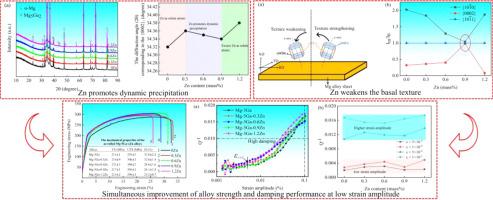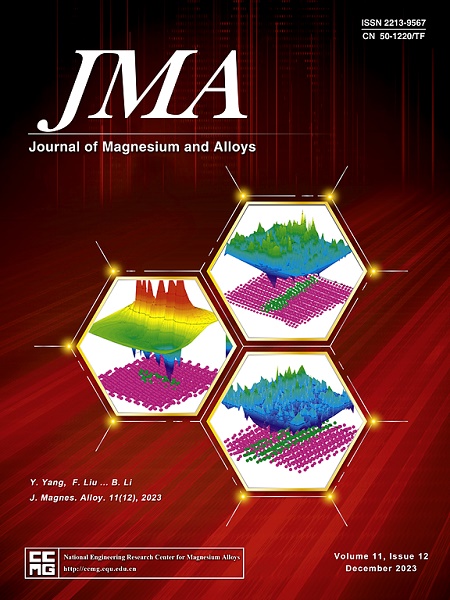Microstructure, mechanical properties and damping behavior of novel Mg-Ga-Zn alloys fabricated by medium-high strain rate rolling
IF 15.8
1区 材料科学
Q1 METALLURGY & METALLURGICAL ENGINEERING
引用次数: 0
Abstract
This study examines the grain characteristics, dynamic precipitation phase characteristics, and texture evolution of Mg-Ga-xZn alloys produced through medium-high strain rate rolling. It investigates the impact of Zn on the mechanical and damping properties of Mg-Ga sheet. The addition of Zn reduces the solid solubility of Ga in α-Mg, facilitating dynamic precipitation, grain refinement, and weakening of the basal texture of the sheet, ultimately enhancing strength and damping performance. The yield strength of the sheet initially increases and then decreases with increasing Zn content. The Mg-5Ga-0.6 Zn alloy demonstrates the best overall mechanical properties, with a yield strength, tensile strength, and elongation of 221 MPa, 304 MPa, and 28.6%, respectively, primarily attributed to fine-grained strengthening. Damping performance at low strain amplitudes also follows a similar trend with increasing Zn content, with Mg-5Ga-0.6 Zn showing the highest damping values. The study suggests that the decrease in damping performance due to Zn can be linked to the reduced solid solubility of Ga in α-Mg. Specifically, at a strain amplitude of 1 × 10–3, the damping values Q-1 of Mg-5Ga, Mg-5Ga-0.6 Zn, and Mg-5Ga-1.2 Zn alloy sheets are 0.0167, 0.0152, and 0.0174, respectively. These findings have implications for the development of bio-implantable magnesium alloys with high damping properties.

中高应变率轧制新型镁-镓-锌合金的微观结构、力学性能和阻尼行为
本研究探讨了通过中高应变率轧制生产的 Mg-Ga-xZn 合金的晶粒特征、动态沉淀相特征和纹理演变。研究还探讨了 Zn 对 Mg-Ga 板材机械性能和阻尼性能的影响。Zn 的加入降低了 Ga 在 α-Mg 中的固溶性,促进了动态析出、晶粒细化和薄片基底纹理的弱化,最终提高了强度和阻尼性能。薄片的屈服强度最初会随着锌含量的增加而增加,然后降低。Mg-5Ga-0.6 Zn 合金的整体机械性能最好,屈服强度、抗拉强度和伸长率分别为 221 兆帕、304 兆帕和 28.6%,这主要归功于细晶粒强化。随着锌含量的增加,低应变振幅下的阻尼性能也呈类似趋势,Mg-5Ga-0.6 Zn 的阻尼值最高。研究表明,Zn 导致的阻尼性能下降与 Ga 在 α-Mg 中的固溶性降低有关。具体来说,在应变振幅为 1 × 10-3 时,Mg-5Ga、Mg-5Ga-0.6 Zn 和 Mg-5Ga-1.2 Zn 合金薄片的阻尼值 Q-1 分别为 0.0167、0.0152 和 0.0174。这些发现对开发具有高阻尼特性的生物植入性镁合金具有重要意义。
本文章由计算机程序翻译,如有差异,请以英文原文为准。
求助全文
约1分钟内获得全文
求助全文
来源期刊

Journal of Magnesium and Alloys
Engineering-Mechanics of Materials
CiteScore
20.20
自引率
14.80%
发文量
52
审稿时长
59 days
期刊介绍:
The Journal of Magnesium and Alloys serves as a global platform for both theoretical and experimental studies in magnesium science and engineering. It welcomes submissions investigating various scientific and engineering factors impacting the metallurgy, processing, microstructure, properties, and applications of magnesium and alloys. The journal covers all aspects of magnesium and alloy research, including raw materials, alloy casting, extrusion and deformation, corrosion and surface treatment, joining and machining, simulation and modeling, microstructure evolution and mechanical properties, new alloy development, magnesium-based composites, bio-materials and energy materials, applications, and recycling.
 求助内容:
求助内容: 应助结果提醒方式:
应助结果提醒方式:


